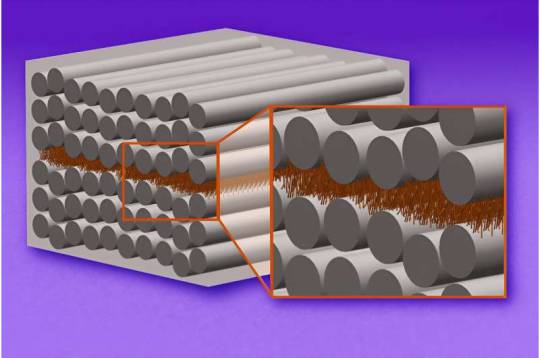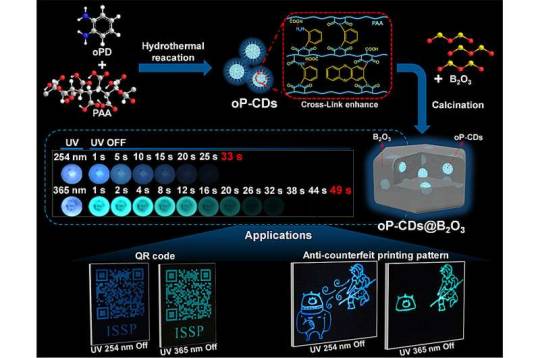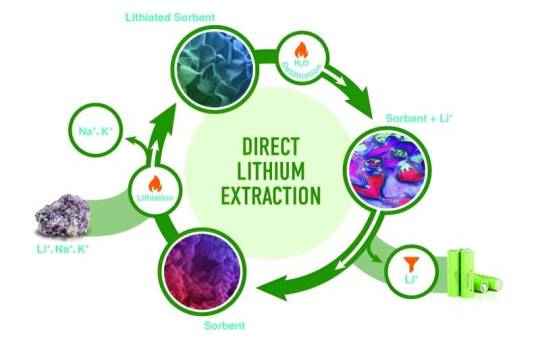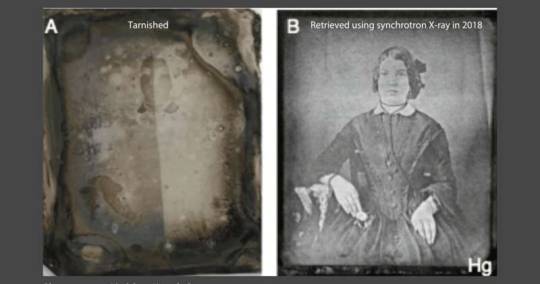Video
youtube
Periodic Videos on YouTube talks about the element thulium, its properties, and the difficulty in isolating this rare earth element.
14 notes
·
View notes
Text

'Nano stitches' enable lighter and tougher composite materials
To save on fuel and reduce aircraft emissions, engineers are looking to build lighter, stronger airplanes out of advanced composites. These engineered materials are made from high-performance fibers that are embedded in polymer sheets. The sheets can be stacked and pressed into one multilayered material and made into extremely lightweight and durable structures.
But composite materials have one main vulnerability: the space between layers, which is typically filled with polymer "glue" to bond the layers together. In the event of an impact or strike, cracks can easily spread between layers and weaken the material, even though there may be no visible damage to the layers themselves. Over time, as these hidden cracks spread between layers, the composite could suddenly crumble without warning.
Read more.
13 notes
·
View notes
Text

Novel method developed for phosphorescent multi-color carbon dots
A research team has devised a novel method to prepare carbonized polymer nanodots capable of emitting multi-color ultra-long room-temperature phosphorescence (RTP) from blue to green.
"These materials exhibit potential applications in anti-counterfeiting and information encryption," said Zhang Qipeng, member of the team.
The research findings have been published in Advanced Science, and the study was led by Jiang Changlong from Hefei Institutes of Physical Science of Chinese Academy of Sciences
RTP materials glow even after the light source is removed, making them valuable for various uses like security features, data protection, displays, and medical imaging. Carbon dots (CDs) are a kind of RTP material known for being easy to make, stable under light, and safe. But making bright and long-lasting RTP materials with CDs is tough due to non-radiative loss of energy.
Read more.
9 notes
·
View notes
Text

Chemists invent a more efficient way to extract lithium from mining sites, oil fields, used batteries
Chemists at the Department of Energy's Oak Ridge National Laboratory have invented a more efficient way to extract lithium from waste liquids leached from mining sites, oil fields, and used batteries. They demonstrated that a common mineral can adsorb at least five times more lithium than can be collected using previously developed adsorbent materials.
"It's a low-cost, high-lithium-uptake process," said Parans Paranthaman, an ORNL Corporate Fellow and National Academy of Inventors Fellow with 58 issued patents. He led the proof-of-concept experiment with Jayanthi Kumar, an ORNL materials chemist with expertise in the design, synthesis, and characterization of layered materials.
"The key advantage is that it works in a wider pH range of 5 to 11 compared to other direct lithium extraction methods," Paranthaman said. The acid-free extraction process takes place at 140 degrees Celsius, compared to traditional methods that roast mined minerals at 250 degrees Celsius with acid or 800 to 1000 degrees Celsius without acid.
Read more.
8 notes
·
View notes
Text

Researchers advance pigment chemistry with moon-inspired reddish magentas
An Oregon State University researcher who made color history in 2009 with a vivid blue pigment has developed durable, reddish magentas inspired by lunar mineralogy and ancient Egyptian chemistry.
Mas Subramanian, distinguished professor of chemistry, and collaborators at OSU report the findings of the study in the journal Chemistry of Materials.
The new pigments, which could be used as energy-efficient coatings for vehicles and buildings, are based on divalent chromium, Cr2+, and are the first to use it as a chromophore; chromophores are the parts of a molecule that determine color by reflecting some wavelengths of light while absorbing others.
"To date, no Earth-based mineral has been reported to contain chromium in the divalent state as one of the components," said Subramanian, the Milton Harris Professor of Materials Science in the OSU College of Science. "However, the analysis of lunar mineral samples collected from Apollo missions showed the occurrence of chromium in the divalent state."
Read more.
16 notes
·
View notes
Text
Imagine a vast volume of porous sandstone reservoir, once full of oil and natural gas, now full of a different, carbon-free fuel -- hydrogen.
Scientists at Sandia National Laboratories are using computer simulations and laboratory experiments to see if depleted oil and natural gas reservoirs can be used for storing this carbon-free fuel. Hydrogen is an important clean fuel: It can be made by splitting water using solar or wind power, it can be used to generate electricity and power heavy industry, and it could be used to power fuel-cell-based vehicles. Additionally, hydrogen could be stored for months and used when energy needs outpace the supply delivered by renewable energy sources.
"Hydrogen would be good for seasonal and long-term storage," said Sandia chemical engineer Tuan Ho, who is leading the research. "If you think of solar energy, in the summer you can produce a lot of electricity, but you don't need a lot for heating. The excess can be turned into hydrogen and stored until winter."
Read more.
10 notes
·
View notes
Text

Case Study: Leadenhall Building Bolt Failure
Not all materials failures are catastrophic, and one such real-world scenario was the failure of bolts in the Leadenhall Building in London (also known as the Cheesegrater). In November of 2014, two bolts of 3,000 (or 'megabolts', due to their size) failed, debris from one of the two failures falling 15 stories. A third bolt failed a few months later and the ultimate cause of these failures was determined to be hydrogen embrittlement. While there were no injuries due to the failures, and no risk of structural failure, concerns arose that that the other 2997 bolts in the structure might also be at risk of failure. The remaining bolts had to be assessed and some replaced, a costly and time-consuming process.
Sources/Further Reading: (Image source - 2019 news article) (2015 news article) (Fastener and Fixing)
10 notes
·
View notes
Text
Elemental Applications: Thulium
With few applications, thulium is commonly used in lasers and as a portable source of X-rays. Other applications of the element include high temperature superconductors, in ferrites, and as a measure against counterfeiting in euro banknotes thanks to its blue fluorescence under UV light.
Source.
24 notes
·
View notes
Text

Trash to treasure—Researchers turn metal waste into catalyst for hydrogen
Scientists have found a way to transform metal waste into a highly efficient catalyst to make hydrogen from water, a discovery that could make hydrogen production more sustainable.
A team of researchers from the University of Nottingham's School of Chemistry and Faculty of Engineering has found that the surface of swarf, a byproduct of the metal machining industry, is textured with tiny steps and grooves on a nanoscale level. These textures can anchor atoms of platinum or cobalt, leading to an efficient electrocatalyst that can split water into hydrogen and oxygen. The research has been published in the Journal of Material Chemistry A.
Hydrogen is a clean fuel that can be used to generate heat or power vehicles, and the only byproduct of its combustion is water vapor. However, most hydrogen production methods rely on fossil fuel feedstock. Electrolysis of water is one of the most promising green pathways for hydrogen production, as it only requires water and electricity.
Read more.
23 notes
·
View notes
Text


Cu 60, Zn 40 (wt%), air cooled - Widmanstätten microstructure
Processing
Homogenised at 850 °C, air cooled
[...]
Sample preparation
Etched in NH4OH/H2O2
Technique
Reflected light microscopy
Length bar
400 μm
Further information
This sample has been air cooled. The fast cooling rate changes the morphology to a 'basket weave' appearance known as a Widmanstätten microstructure. The α phase precipitates out of the single β phase during cooling to give α plates in a β matrix. The plates form in order to minimise strain energy.
Contributor
Prof T W Clyne
Organisation
Department of Materials Science and Metallurgy, University of Cambridge
Sources: (Image 1) (Image 2)
#Materials Science#Science#Magnified view#Optical microscopy#University of Cambridge#Copper#Zinc#DoITPoMS
5 notes
·
View notes
Text

A novel machine learning model for the characterization of material surfaces
Machine learning (ML) enables the accurate and efficient computation of fundamental electronic properties of binary and ternary oxide surfaces, as shown by scientists from Tokyo Tech. Their ML-based model could be extended to other compounds and properties. The findings, published in the Journal of the American Chemical Society, could aid in the screening of surface properties of materials as well as in the development of functional materials.
The design and development of novel materials with superior properties demands a comprehensive analysis of their atomic and electronic structures.
Electron energy parameters such as ionization potential (IP), the energy needed to remove an electron from the valence band maximum, and electron affinity (EA), the amount of energy released upon the attachment of an electron to the conduction band minimum, reveal important information about the electronic band structure of surfaces of semiconductors, insulators, and dielectrics.
Read more.
#Materials Science#Science#Machine learning#Materials characterization#Surfaces#Computational materials science#Tokyo Institute of Technology
5 notes
·
View notes
Text

New colorful plastic films for versatile sensors and electronic displays
Innovative electronics is one of the many applications of modern plastics. Some recent research efforts have used plastic to improve the color realism of display technologies.
Now, in a study recently published in Angewandte Chemie International Edition, researchers from Osaka University and collaborating partners have developed a borane molecule that exhibits unusual light emission upon binding to fluoride. Incorporating their molecule into common plastic is straightforward, resulting in versatile materials for electronic display and chemical sensing applications.
A class of molecules known as triarylboranes (TABs) has photochemical properties that are useful in optics. For example, upon binding to an anion such as fluoride, disruption of the TAB electronic structure often does two things to the light emission: shortens the wavelength (blue-shift) and reduces the intensity (turn-off response).
Read more.
#Materials Science#Science#Plastics#Polymers#Sensors#Electronics#Color#Molecules#Photochemistry#Boron
4 notes
·
View notes
Text
While 3D printing has exploded in popularity, many of the plastic materials these printers use to create objects cannot be easily recycled. While new sustainable materials are emerging for use in 3D printing, they remain difficult to adopt because 3D printer settings need to be adjusted for each material, a process generally done by hand.
To print a new material from scratch, one must typically set up to 100 parameters in software that controls how the printer will extrude the material as it fabricates an object. Commonly used materials, like mass-manufactured polymers, have established sets of parameters that were perfected through tedious, trial-and-error processes.
But the properties of renewable and recyclable materials can fluctuate widely based on their composition, so fixed parameter sets are nearly impossible to create. In this case, users must come up with all these parameters by hand.
Read more.
16 notes
·
View notes
Text

The Second Law of Thermodynamics
The second law of thermodynamics establishes the concept of entropy and constrains natural heat transfer. Simply put, it states that heat spontaneously flows from hot to cold. The second law refines scenarios that would be permissible under the first law (for example, heat flowing from cold objects to hot objects does not violate conservation of energy), narrowing down further what natural processes actually occur.
In other words, the second law could also be stated as follows:
The entropy of a cyclic process with either increase or stay the same
Not all heat can be converted to work in a cyclic process
Sources/Further Reading: (Image source - NASA) (HyperPhysics) (Wikipedia) (New Scientist)
11 notes
·
View notes
Text
Life and the Elements: Thulium
Though thulium exists in small amounts in the human body, it does not have any known biological roles. Like several other rare earth elements, thulium salts have been known to stimulate metabolism and soluble salts are mildly toxic while insoluble salts are completely nontoxic. Injected thulium can cause liver damage and the dust and powder forms of the element are toxic upon inhalation or ingestion and can cause explosions.
Source.
28 notes
·
View notes
Text

Research revives 1800s photos
Researchers from Western University developed techniques for creating images from old, badly tarnished photographs. These techniques could also be used to study other historic artifacts and fossils and prevent corrosion in modern materials.
Chemistry professor Tson-Kong (T.K.) Sham and his colleagues recently confirmed a new synchrotron imaging technique they developed is just as effective for retrieving corroded daguerreotypes—the earliest form of photographs—as a strategy they first reported in 2018 and can also be used no matter how badly damaged the image surface is from natural corrosion or cleaning attempts.
The new research, which used beamlines at the Canadian Light Source (CLS) at the University of Saskatchewan, is published in the Journal of Cultural Heritage.
Read more.
13 notes
·
View notes
Text

Palladium nanocluster catalyst supports highly efficient and regioselective hydrogenation of epoxides
Alcohols are widely applied in life sciences and the chemical industry. Selective hydrogenation of epoxides using hydrogen molecules as a reductant is considered to be one of the most facile and atom-economical strategies for alcohol synthesis. However, controlling the regioselective ring opening of epoxides remains a challenge.
Significant progress has been made in the selective hydrogenation of epoxides using homogeneous catalysis. However, challenges remain in the difficult separation and recovery of the catalyst, as well as the drawbacks of requiring expensive and sophisticated ligands, which severely limit their practical potential. Therefore, the development of efficient and highly regioselective heterogeneous catalysts for epoxide hydrogenation is particularly important.
A palladium (Pd) nanocluster catalyst for the selective hydrogenation of epoxides has been developed by Yang Yong from the Qingdao Institute of Bioenergy and Bioprocess Technology of the Chinese Academy of Sciences.
Read more.
4 notes
·
View notes